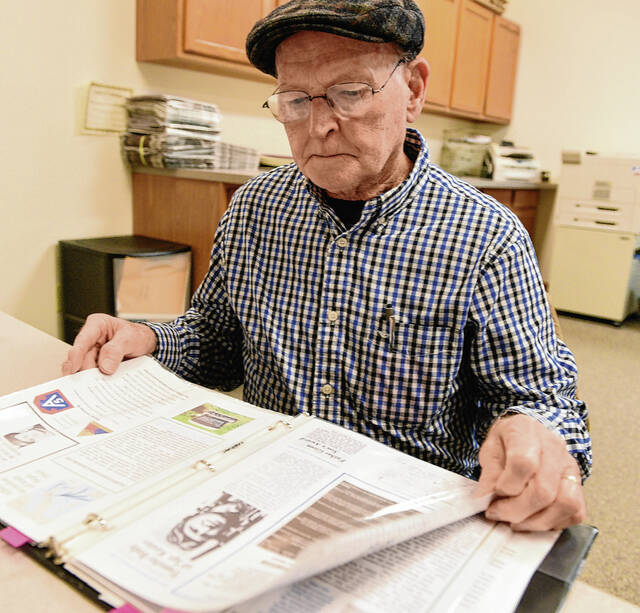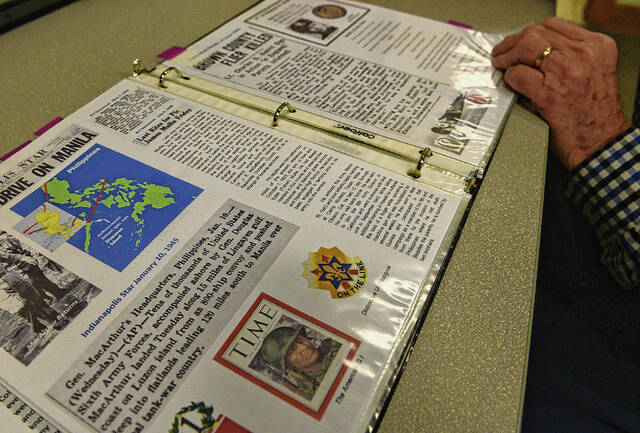
Resident Jim Watkins created “The Fallen,” a book to memorialize soldiers who never returned home to Brown County after serving in World War II. Watkins continues to seek information about these fallen soldiers, including Phillip Smith who Watkins was unable to find any information about during his research. Watkins will soon write a regular column for the Brown County Democrat, telling the stories of these soldiers who gave the ultimate sacrifice to their nation. Suzannah Couch | The Democrat
By SUZANNAH COUCH and ABIGAIL YOUMANS
This week the nation remembers its entrance into World War II after the attack on Pearl Harbor on Dec. 7, 1941.
When Pearl Harbor was attacked 80 years ago, Brown County had 61 men serving in the military and nine who had been recently discharged.
On Dec. 11, 1941, the first paper published after the bombing, the Brown County Democrat was reporting that the nine would soon be recalled, and three more young men were on their way to Indianapolis to enlist.
By the end of WWII, the lives of more than 418,000 U.S. soldiers had been lost. The Brown County War Memorial at the courthouse records the names of 664 men who served in World War II. At least 25 of those men were killed during the war, according to research done by resident Jim Watkins.
There names were: James Albert Ault, Charles R. Barnes, James Wilson Bond, Jesse T. Campbell, John William Crump, Howard Lee Ellis, Joseph J. Floyd, Robert K. Fox, James Robert Gregory, Earl Harden, Harry Cifton Kent, Jacob M. Kesler, Herman O. Knose, James F. Long, James Allen Mullis, Charles Glenn Noblitt, Leroy C. Pearson, Homer Allen Powell, Phillip Smith, Frank Snyder Jr., James Victor Stringer, Clifford W. Swift, Marvin Earl Tutterow, Robert Van Sickle and Raymond Floyd Wells.
Using newspaper archives and records at the Brown County Historical Society, Watkins worked for a year compiling a 50 page memorial document about the Brown County boys who never returned home from the second world war titled “The Fallen.”
He first presented his memorial project to the Historical Society during a monthly meeting in 2019. A copy is available at the History Center.
Watkins was born the same year as the Pearl Harbor attack.
Though he was a child during WWII, it has been the area of greatest interest to him while studying history.
His personal firsthand knowledge of the U.S.’s role in WWII came from listening to stories at family gatherings from his uncles and cousins who all served in the U.S. Navy during the war. His family members had returned from the war just before Watkins entered school.
Watkins’ cousin, James McGuinness, did not return from the war. He perished in a submarine in the Pacific Ocean.
Growing up around that time and dealing with the loss of his first cousin, WWII was always a topic of conversation. Photos of McGuinnes were on the mantle of every family member’s house Watkins’ family would visit.
“I think that had a lot to do with my interest in that time period,” Watkins said of losing his cousin in the war.
McGuinness died in a submarine during a test run. The location of the submarine was not discovered until 2017. But where the submarine ended up was in such a deep area of the ocean that it has never been reclaimed, Watkins said.
“They are not able to bring it up because it’s too deep, but at least they know the exact spot,” he said.
McGuinness was stationed in Hawaii with his uncle, who was also Watkins’ uncle. Their uncle had told McGuinness to not go on the test run, but he went anyways.
“That’s what’s so sad about several of these guys. They didn’t die in combat. They died by accident,” Watkins said about Brown County’s fallen soldiers.
“So many of them died within a year of getting into the service.”
Watkins grew up in Indianapolis and went to Broad Ripple High School. He attended Marion College, which is now Marion University, and later received his masters from Butler University.
He was in middle school education for 42 years. He taught history, geography and English. He was also a guidance counselor and athletic director. He coached a couple of sports, too.
In retirement, Watkins reads a lot about history, with half of his reading focused on WWII.
He and his wife, local artist MK Watkins, moved to Brown County about 10 years ago. MK’s parents had a camper at the Shady Oaks Campground in the Bean Blossom area. The couple visited Brown County since the 1960s. Jim and MK eventually had their own camper at the spot until around 2010.
Around that time, their oldest daughter and her husband bought a cabin on Clay Lick Road with four acres. Jim and MK bought two of those acres for their own home in Brown County.
Jim said there was a “magnetic attraction” between artist MK and the hills of Brown County, which has been home to artists for decades.
In 2014, Jim joined the Brown County Historical Society. Then in 2018 he began his research into the fallen Brown County boys, searching newspaper archives and other records there.
In one of the main halls of the History Center there is a display of WWII items that included the names of the soldiers, information about their families, when they were born and when they died during the war.
Jim thought more could be shared about these men, so he went to work learning about the fallen soldiers from Brown County.
After several months, Watkins found the names of 25 soldiers who never returned home to Brown County after the war. His research shows where the men were born, the names of family members, when they entered the service, where they trained, what some of their jobs were before going to war, the dates and locations of where they were killed in action and where the men are buried.
Black and white newspaper clippings and photos of young, smiling faces line the pages along with photos of gravestones and maps showing where the men died. The book details the different military divisions the men served in and some of the attacks the men perished in.
There is only one soldier Jim has been unable to find any information on: Phillip Smith.
He hopes the community can help him learn more about Smith and his ultimate sacrifice. Anyone with information on Smith or any other WWII solider who never made it back home to Brown County can email Jim at [email protected].
“The Fallen” ultimately shares the stories of young men making the ultimate sacrifice for their country, like a 19-year-old Charles R. Barnes. Barnes entered the service in September 1944 and was sent overseas less than a year later in March 1945, only to be killed two months later in Okinawa.
Or 25-year-old Cpl. Raymond Floyd Wells from Gnaw Bone who entered the service on May 11, 1942. Two months after the war concluded, Wells was on the first leg of his flight home when his flight crashed on the approach to Fort Richardson in Anchorage, Alaska.
“The numbers of those who died in plane accidents and training accidents; it’s incredible how many. Before they ever reached the battlefield,” Jim said.
One story that suck with Watkins from his research was that of Lt. James “Jimmy” Bond who served with the Army Air Corps. He entered the service in 1942.
“He went through all of this training and died on his first mission. He went through all of this training to become an officer and on his very first mission to Germany his plane was shot down,” he said.
Jim hopes now to share more about the lives of the fallen WWII soldiers with the community. He plans to write a regular column for the Democrat detailing the lives of these men.
He said that it’s possible in ten years’ time, those who lived during the war may no longer be with us. With that being the case, it’s important to share these stories now.
“This is the 80th anniversary of Pearl Harbor and the United States’ entry into the war. This is one of the last opportunities to have people rethink that time of their lives,” Jim said.
“Normal life was turned on its head on Dec. 7.”







